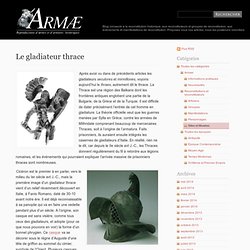

Article Gladiator du Dictionnaire Daremberg et Saglio. Index Gladiateurs et chasseurs. The classes of gladiators - Gruppo Storico Romano. Introduction The aim pursued this article is to try to shed light on the types and the equipment of gladiators, their evolution and transformation during the seven centuries in which the protagonists were in the Roman amphitheatres.

Given the lack of data obtainable from the writings of ancient authors, who have skinny detail, both on the rigging on the types that, over the years has made reference to information derived mainly from inscriptions, from representations of gladiators on bas-reliefs, from tombstones and other objects, as well as that inestimable treasure of shields, helmets and greaves found under the ashes of Vesuvius in Pompeii. Despite this, the debate among scholars is still open and the opinions and theories are often conflicting. But you cannot disregard a basic premise, namely that the various classes of gladiators, and hence its armament, did not exist all at once. The Republican period The munera gladiatoria made their appearance around the third century in Rome. Gladiators. In ancient Rome, gladiators fought, often to the death, to entertain crowds of spectators.

Gladiators were trained in ludi ([sg. ludus]) to fight well in circuses (or the Colosseum) where the ground surface was covered with blood-absorbing harena 'sand' (hence, the name 'arena'). Slaves chosen as gladiators tended to be 1st-generation slaves bought or acquired in war or condemned slaves. Gladiators Were Sometimes Indulged: Popular, skilled gladiators could become very wealthy and have families. Before combats gladiators were provided with lots of food (albeit food that focused on the nutritionally inferior grain barley). Types: Gladiator Fights – How Did Gladiator Fights End. The fights between gladiators in ancient Rome were brutal.

It was not like a football game (American or otherwise) where it would be assumed that both sides would go home with just a couple of bruises. Death was a common occurrence at a gladiatorial game, but that doesn't mean it was inevitable. One gladiator might be lying prone in the blood-absorbing sand of the arena, with the other gladiator holding a sword (or whichever weapon he was assigned) at his throat. Instead of simply plunging in the weapon and consigning his opponent to death, the winning gladiator would look for a signal to tell him what to do. The Editor Was in Charge of the Gladiator Fight The editor of a game, whether senator, emperor, or other politico, made the final decisions about the fates of the gladiators in the arena. Before proceeding, try the Gladiator Thumbs Up Trivia Question. 3 Ways to End a Fight Between Gladiators If the editor wished, he could order the fight to last until "the finger.
"
Retiarius / Rétiaire. Secutor. Provocator. Thrax. Le gladiateur thrace. Après avoir vu dans de précédents articles les gladiateurs secutores et mirmillones, voyons aujourd’hui le thraex, autrement dit le thrace.

La Thrace est une région des Balkans dont les frontières antiques englobent une partie de la Bulgarie, de la Grèce et de la Turquie. Il est difficile de dater précisément l’entrée de cet homme en gladiature. La théorie officielle veut que les guerres menées par Sylla en Grèce, contre les armées de Mithridate comprenant beaucoup de mercenaires Thraces, soit à l’origine de l’armatura. Faits prisonniers, ils auraient ensuite intégrés les casernes de gladiateurs d’Italie. En réalité, rien ne le dit, car depuis le IIe siècle avt J. Cicéron est le premier à en parler, vers le milieu du Ier siècle avt J. Son arme offensive est la sica. Thraex_antalya.jpg (JPEG Image, 330 × 450 pixels) Gladiateurs : Thrace Mirmillon. Mirmillones. Le gladiateur mirmillon. Le gladiateur mirmillon est sans doute l’un des plus connus des arènes romaines.

Pourtant, l’idée que l’on s’en est fait pendant longtemps était fausse, car basée sur un texte mal interprété de l’auteur latin Festus. Celui-ci rapportait une chanson entonnée par l’adversaire du mirmillon, le rétiaire (qui se battait avec un filet et un trident) et qui disait « pourquoi fuis-tu Gaulois ; ce n’est pas après toi que j’en veux, c’est après ton poisson ». Beaucoup se sont donc ingéniés à chercher sur les images antiques la représentation d’un poisson sur un casque, et ne le trouvant pas, peintres et dessinateurs l’ont carrément inventé.
On peut en voir une illustration sur le célèbre tableau de Léon Jérôme (ci-dessus), intitulé « pollice verso » figurant la fin d’un duel entre un rétiaire (au sol) et un mirmillon triomphant demandant la sentence à l’éditeur des jeux dans sa loge. Un joli poisson orne le devant de son casque… En réalité, ce poisson n’a jamais existé.
Voir : Hoplomachus. Duelli Militari Ars Dimicandi anno 2010.